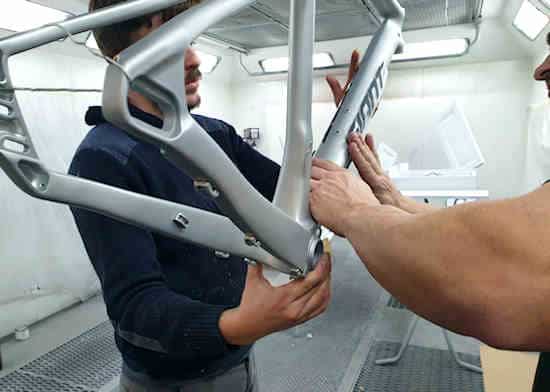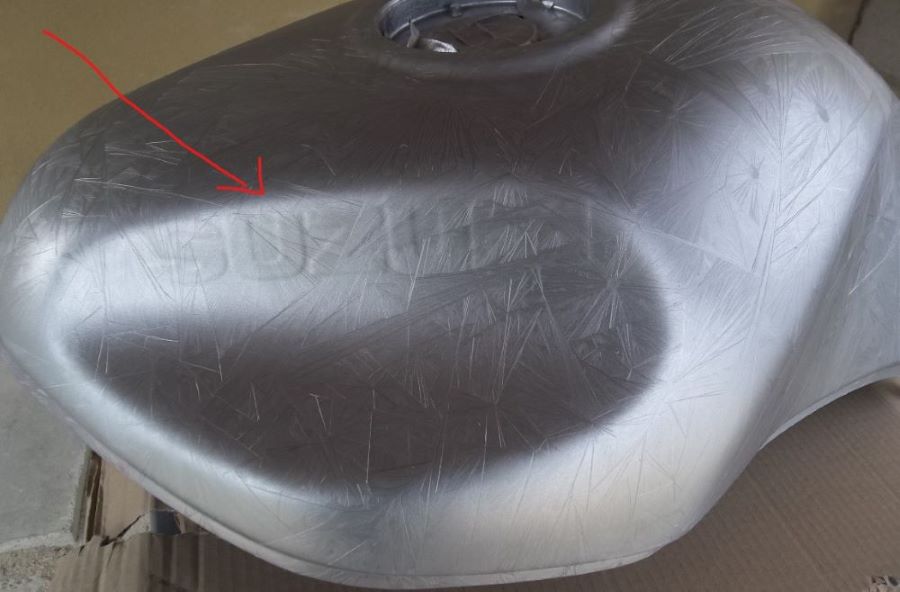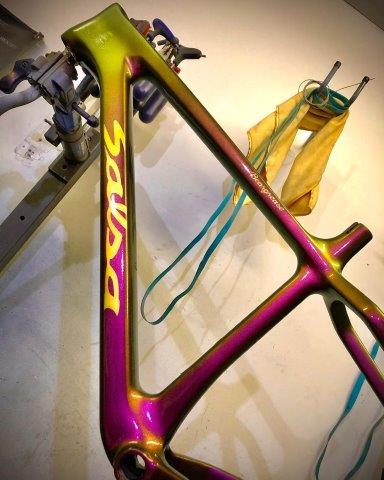All Products are in stock
and shipped from France.
Delivery within 48 hours.
and shipped from France.
Delivery within 48 hours.
Our categories
 How to apply stickers in body paint ?
How to apply stickers in body paint ?
This is a subject that often comes up through the technical questions concerning the preparatory work for painting and in particular the installation of adhesive decorations printed on a personalization painting.
Painting on stickers or rather varnishing on stickers is a particularly common practice in decoration, or "custom painting" on bicycles and often also on motorcycles. This involves sticking logo stickers on the frame of the bike, on the tank or the fairings. Adhesives are also found on the helmets.
► Should we put the adhesives on the clearcoat? Or on the painting?
Most professional painters paint the clearcoat directly on the stickers, because you should never put a sticker on the clearcoat: the sticker would not be protected from abrasion and weather, or even cleaning products or gasoline, and also, it would form an unsightly extra thickness. For this reason, we always place the stickers under the clearcoat.
On the other hand, the clearcoat creates a more or less thick layer (about 50 microns for 2 coats, which is very similar to the thickness of the stickers) which is shiny and which will embellish the sticker. When you have a clearcoat on top of the sticker, it looks like the sticker is blending into the paint and that the bike frame, or the motorcycle tank, are original.
There are several ways to do it and we will show you all the tips and techniques for applying logo stickers to your bike frame or fairing.
How many coats of clearcoat does it take to properly cover a sticker ? In general, most professionals apply two coats of clearcoat. This is sufficient to give an acceptable appearance. If you want to completely smooth the surface, just do a light sanding the next day and reapply two coats.
► Should we remove adhesives from a motorcycle helmet or tank before painting?

It is always best to remove adhesives, as many coats of primer would be required to level out this relief. The adhesives under the varnish: it is therefore necessary to sand with P320 abrasive paper to reach the adhesives. Using a heat gun or hair dryer, heat the adhesives for easier removal. It is then easy to remove them with the tip of a scalpel.
Then sand to reduce unevenness and fill with filling primer in 2 coats.
Solutions for painting on stickers or adhesives
The question that comes up very often is knowing when to apply the adhesives. As we said in the previous paragraph, the adhesive logos must be glued between the paint and the clearcoat.
The technique is the same and the drying time too, depending on whether you are painting a base paint. of water or a solvent-based paint.
In general, when the paint has been applied with the spray gun, the adhesives can be deposited after 15 minutes for solvent-based paints.
You have a lot more time available when you paint with water-based paint. Make sure the paint is dry. There is no need to wait hours for the paint to be completely dry. We are used to working with painters decorating bicycles and we observe that the application of the stickers takes place within 20 to 40 minutes after the application of the water-based paint. Moreover, even solvent-based bodywork clearcoats, which are used on bicycles, are applied to automotive-type water-based paints, after only 30 minutes. So do not be afraid of a possible presence of solvents or non-evaporated water in the heart of the paint and trapped under the sticker (and the clearcoat), which could come out later in the form of blisters or bubbles.
When we speak with a solvent-based paint, that is to say a “two-coat” paint, then there is a time limit for varnishing. Indeed, if it takes longer than 30 minutes at 20° to apply the clearcoat, without sanding, then this clearcoat is not guaranteed to hold perfectly on the paint, because the latter has "closed", that is to say, it has dried on the surface and optimal grip is no longer possible.
When there are a lot of stickers to put on the paint before varnishing and you want to work quietly and with precision, then it is better to work on a dry and sanded paint. On the contrary, if you only have one or two stickers to apply before varnishing, then it is perfectly possible to stick the adhesives after 15 minutes and to clearcoat the painting immediately.
 How and when should stickers be varnished ?
How and when should stickers be varnished ?
When should you clearcoat? It doesn't matter, because the stickers can be varnished immediately. We still recommend applying a first coat of grip with the clearcoat, that is to say a very thin layer, to prevent any reaction, before applying, in a very classic way, two beautiful shiny coats of clearcoat.
Watch out for the glue ! If you think you left glue from a transfer sheet when applying the stickers, then it must be removed, using an anti-silicone degreaser.
Regarding the compatibility of the stickers: do not worry about this, because most stickers in PS or PP, i.e. all the materials, on which printers print and cut of adhesives, are perfectly compatible and will not be damaged by clearcoat solvents.
A tip for applying correctly : so that they are straight and parallel, you can first apply a few thin adhesive lines as a guide. These are offered in the “adhesives” category of the StardustColors website.
Removing stickers from a helmet, tank or bike frame
This is a problem faced by all painters on bicycles, motorcycles and helmets.
On the original fairings and tanks of motorcycles, for example, there are still adhesives with the name of the brand representing the logo. Of course, these elements are never painted in the factory. Manufacturers and manufacturers of motorcycles, bicycle helmets, simply use adhesives.
If you want to repaint directly above the clearcoat, you will see the relief of the logo appear under the bottom clearcoat.
In this case, there are 2 solutions to avoid this annoying defect:
1/ sand the clearcoat until you reach the adhesive underneath. Then, with a heat gun or a dryer, heat the sticker underneath and remove it with the tip of a scalpel. We then end up with a kind of hole that will have to be sanded, then filled with a primer.
2/ the easiest solution, but not the best, is to leave the decals on and apply as many coats of a filling primer as necessary on top, then sand.
Make the stickers at a printer
Ordering a print of your sponsor's or brand's logos is very easy : contact any printer in your area. Normally, most printers provide services for the printing of adhesive stickers. All you have to do is give them a high definition photo or a PDF file of your project.
They will also need to be sized in height and width to suit your motorcycle tank or bike frame.
In general, there are no different qualities. Most of the materials used by printers (PS, PP) show excellent resistance to sunlight and temperature. However, you can still ask your printer about color fastness in the sun.
Mixing and diluting paint
Surface preparation techniques
Choosing the right primer or filler














































































